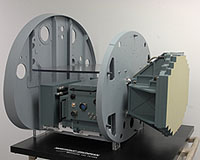| . |  |
. |
Shivta, Israel (AFP) July 24, 2009 Fondly patting his dust-covered rifle at the end of day-long shooting practice, Israeli platoon commander Afik Soher says he wouldn't replace it with any other. Israel's army is gradually phasing out the veteran US-made M-16 assault rifle in favour of the modern, home-produced Tavor, which has become a symbol of pride for the Givati infantry brigade where it first became standard issue. "It's a great gun and I wouldn't trade it for anything," Soher says. Malfunctions cut short earlier attempts to introduce it to troops and the weapon was used on a wide scale for the first time during this year's war in the Gaza Strip, when it performed with no reported problems. The acrid smell of gunpowder fills the air of the sandy shooting range in the heart of the Negev desert in southern Israel where recruits, mainly in their late teens, are spending the week practising shooting techniques. Wearing full combat vests and camouflage helmets, the company soldiers run in file into the shooting range, take positions and fire five rounds towards a cardboard target positioned 100 metres (yards) away. They then run through the case-littered stretch of sand to check their shots before comparing their results. "It is fun working with it because soldiers have special motivation to hold an Israeli-made rifle," says company commander Second Lieutenant Yinon Guttel. The TAR-21, or "Tavor Assault Rifle - 21st Century", is made of strong, composite materials and features an integral electro-optical sight and a bullet-loading action mechanism located in the butt stock which makes it short and ergonomic. However, the Tavor, the Hebrew name for mount Tabor in northern Israel, uses the same 5.56 millimetre cartridges and magazines as the M-16. "Advanced countries with modern armies develop their own weapons. We have our tank, now our infantry has a rifle," says Guttel. Designed to meet urban fighting requirements that Israeli troops first encountered during the 1982 Lebanon invasion, the Tavor has been years in research and development. Work on it was begun by the now-privatised Israel Weapons Industries, with the aim of replacing the ageing M-16 and the locally-manufactured but unpopular Galil rifle. "The gun was developed on the basis of lessons drawn during the First Lebanon War," said Zalman Sheves, head of development department of the Tavor at IWI, referring to the 1982 invasion. "The IDF (Israel Defence Forces) fighters encountered urban warfare for the first time in a massive way, which was completely different from previous wars. The conclusions were that a very compact, light rifle that can be easily used in rooms and when getting off vehicles was needed." "We applied in the gun everything the IDF wanted a future rifle to be after the war," he said. The IWI factory has produced thousands of the Tavor rifles in recent years for the Israeli army as well as for an undisclosed number of foreign clients. Sheves refused to give the rifle's price. The Israeli army began issuing the gun to the Givati brigade, one of five infantry brigades in regular forces, in 2006, but suspended use just months later after numerous malfunctions were exposed. In August 2008 the TAR-21 was reintroduced in Givati and today the entire brigade is equipped with it, while other brigades are gradually being supplied. Unlike the M-16 that has been used by dozens of armies in numerous battlefields across the world from Vietnam in the 1960s to Iraq and now Afghanistan, the Tavor has yet to fully prove its effectiveness. The 22-day war in Gaza in December-January was the first major offensive in which Israeli troops used the rifle and no malfunctions were notified. The main difference between the Tavor and the M-16 is the use of the Bullpup configuration in the Tavor, where the action and magazine are located in the buttstock, considerably shortening the rifle's length. "For someone who has also had an M-16, I must say that I would recommend to assign new recruits with the Tavor," says Guttel. "It was built on the basis of an existing rifle but included modifications and improvements of the M-16's flaws, such as fitting it for left-handed (people), a short weapon that better fits urban warfare but that can still fire long distances." Sheves says replacement of the M-16 with the Tavor reflects the change in warfare in the 20th and 21st centuries. "The M-16 is a very veteran rifle that was developed in the early 1960s. It is a good rifle but the needs in the battle field have changed. The M-16 was a good fit for warfare in the 1960s and 1970s that involved open areas and fortified targets. The Tavor is better fitted than the M-16 to the modern battle field," he told AFP. Share This Article With Planet Earth
Related Links The latest in Military Technology for the 21st century at SpaceWar.com
 Successful SABR Fit-Check Aboard F-16
Successful SABR Fit-Check Aboard F-16Baltimore MD (SPX) Jul 24, 2009 Northrop Grumman's newest active electronically scanned array (AESA) fighter sensor, the Scalable Agile Beam Radar (SABR), has been successfully installed on a U.S. Air Force F-16 at Edwards Air Force Base, Calif. In November, SABR began a series of flight demonstrations aboard the company's test aircraft, successfully detecting and displaying multiple aerial targets and generating high ... read more |
|
| The content herein, unless otherwise known to be public domain, are Copyright 1995-2009 - SpaceDaily. AFP and UPI Wire Stories are copyright Agence France-Presse and United Press International. ESA Portal Reports are copyright European Space Agency. All NASA sourced material is public domain. Additional copyrights may apply in whole or part to other bona fide parties. Advertising does not imply endorsement,agreement or approval of any opinions, statements or information provided by SpaceDaily on any Web page published or hosted by SpaceDaily. Privacy Statement |